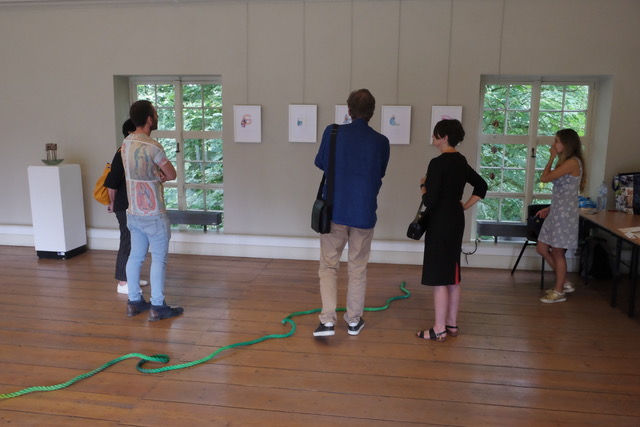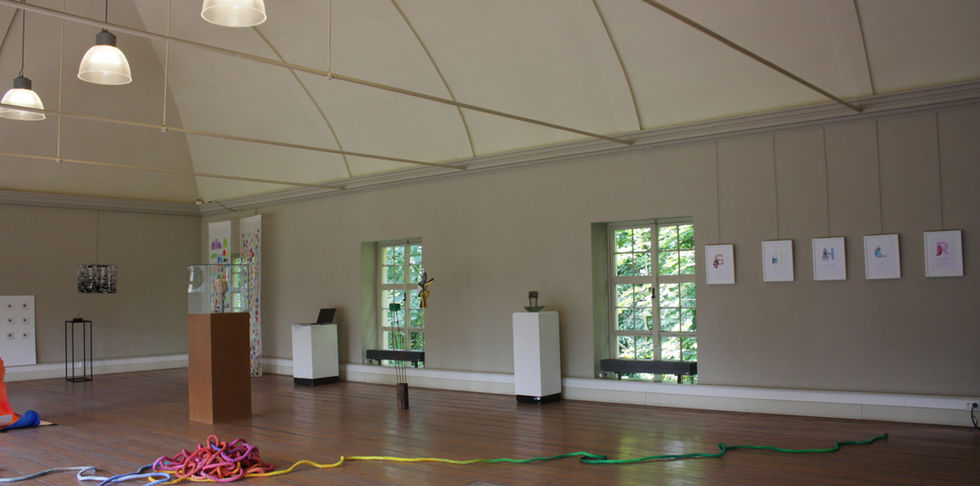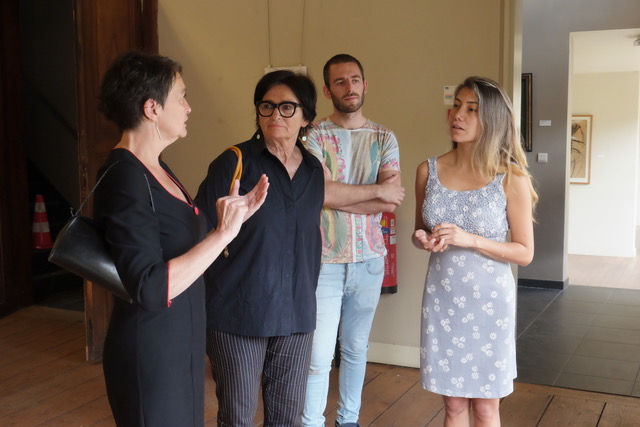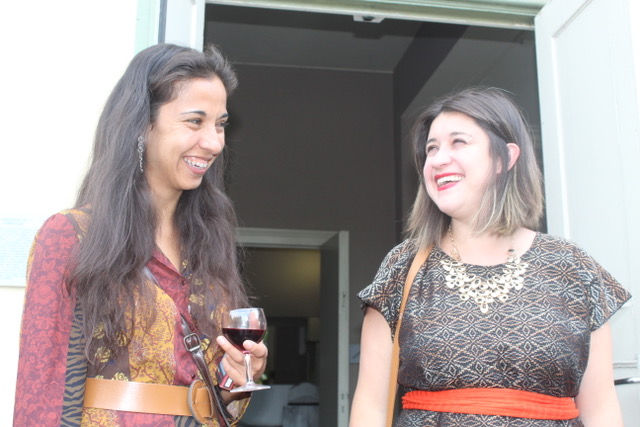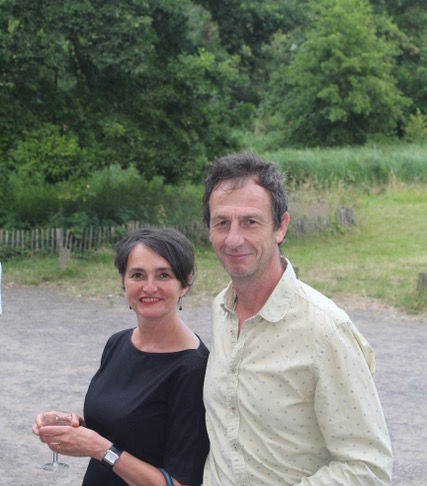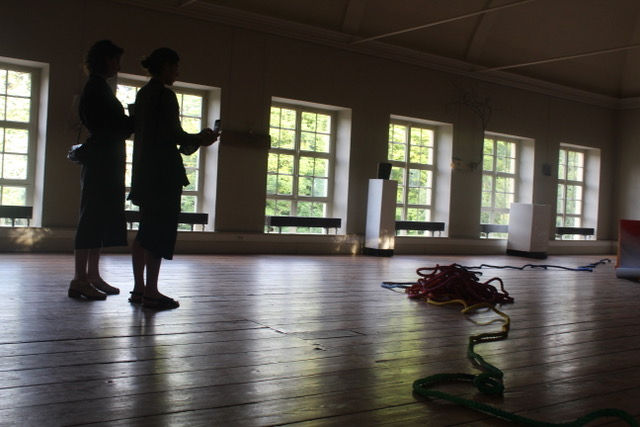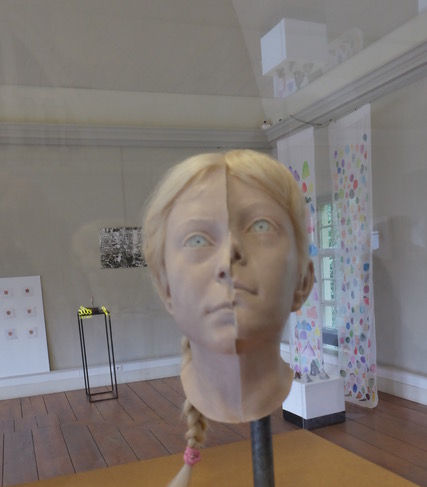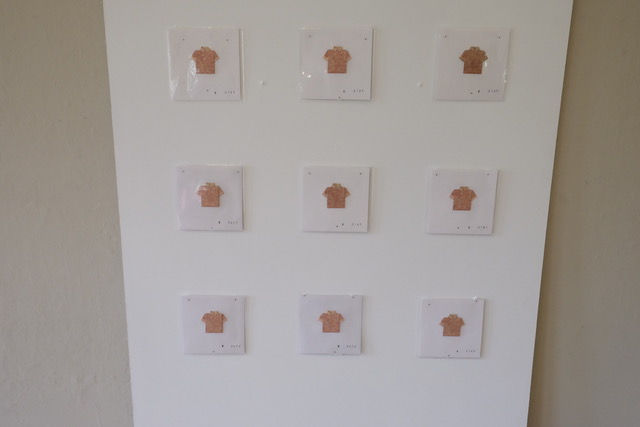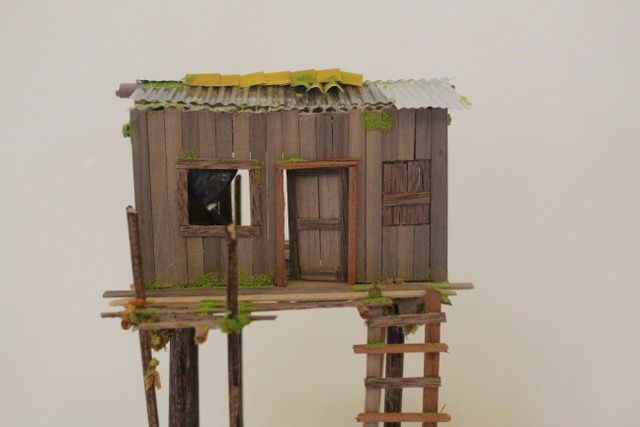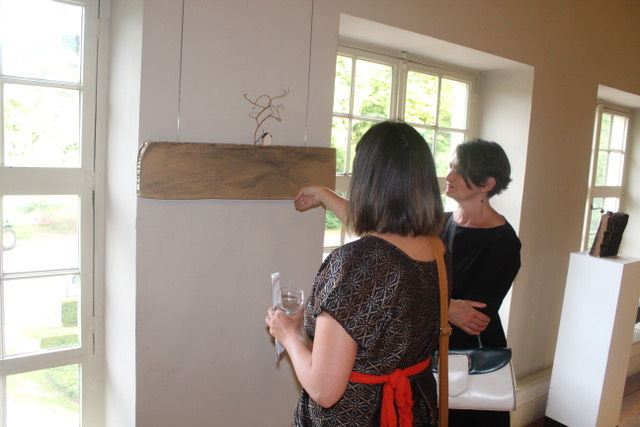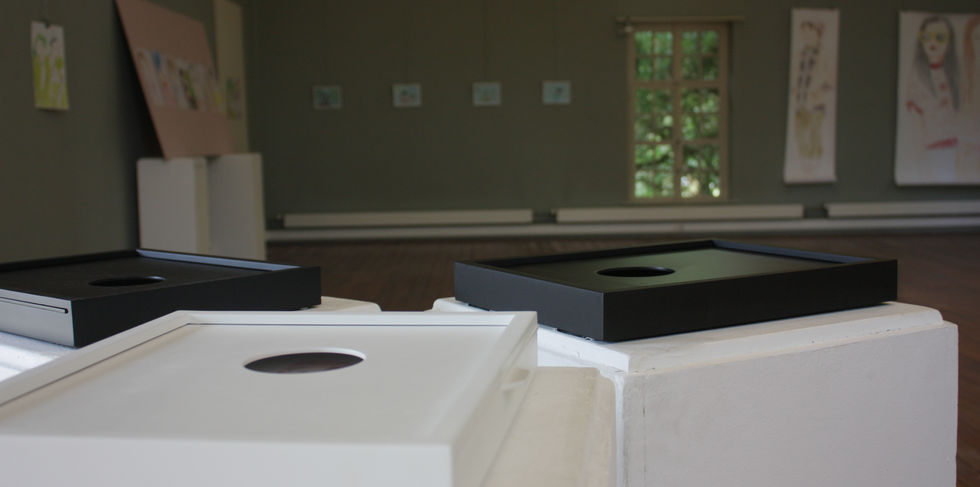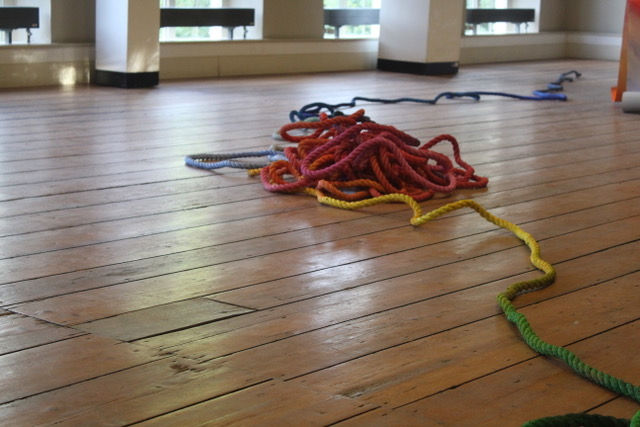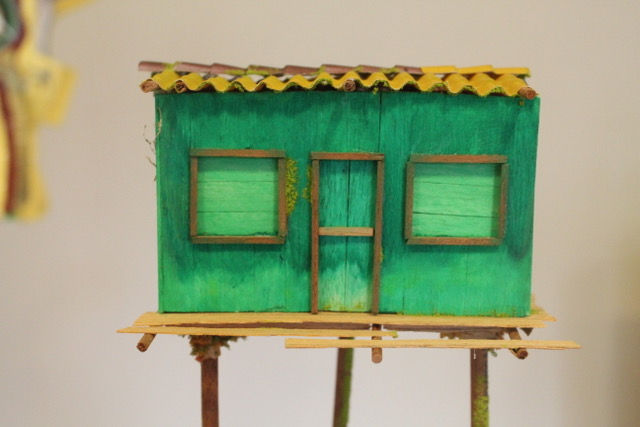

























The title of the exhibition is "Until the Wolf is There", named after a children's song of the same name. The song goes "Let's play in the forest until the wolf is there, is the wolf there?" And then the wolf answers what activity he performs to start his day. While the wolf prepares himself, the children play. The wolf gets up, brushes his teeth, bathes and dresses, until he is ready to hunt. Then the wolf answers the children that he is already there and that he will eat them. He then continues to hunt them and the children start to run.
UNTIL THE WOLF IS THERE shows a duality: a bizarreity. The works look beautiful, but delve on more complex underlying themes that are the result of social or personal problems. Both the positive (the forest, the jungle, the infant, the family, the celebration of life) and the negative (the wolf, the predator, fear, lack of resources, conflict) take part in this play.
"Not all that shines is gold",
Popular saying.
Some of the topics dealt with are: deprivation, migration, war and depletion of natural resources, but also mental states: depression, anxiety, loneliness, vulnerability and difficulties to feel, amongst others. However, the exhibition shows as well how in complex contexts there are individuals or prosesses able to counteract or stand. Despite feelings that could catalogue someone as weak, fragile or sad amongst others, a person can be beautiful in its fragility, very strong by living with it and very lovely -to have empathy- towards others. Despite the violence, subjects can show admirable strength in the shape of love and community. Despite continuous acts against nature, it can show also its strength and the possibility to overcome.
Finally, it must be said that the beauty of the works give them a fairytale notion -that might feel also as awkward beauty- and this fits well with the location of the castle.
-PARCE

ARTISTS
The following texts of the exhibition are a mix of the own words of the artists and the words of Parce. Therefore, they include individual appreciations of every artist and the perspective, thoughts and dialogues that the Parce Director found while organizing and creating this exhibtion.
Peter Land (DK)
Title: Absolute perfection
Year: 2013
Technique: silicone, wax, fabric, mirror
Format: 40 x 15 x 20 cm
The work explores the connections and juxtapositions between the ideas of perfection and performance.
Much of Peter Land’s practice deals with the fine line between the real and the surreal, as he examines the realities of the human condition. Therefore, his figures give the spectator an uneasy feeling increased by the fact that they are young children. The use of young children and their naiveté and innocence of youth is contrasted by their very adult-like expressions and posture. Their posture and appearance may confront us with the adult ideals of perfection and failure, that can turn into preassure and expectation placed on children. It shows "an internal sensitivity and a kind of external, masked toughness that is undoubtedly shared by Land" (1)
Using himself as his primary source for research, Peter Land often transposes himself into his work, revealing his own vulnerabilities.
The idea of the child that has to fulfill expectations can be extended to the idea of the artist himself as someone that has to perform and succeed for an audience. In the words of Galleri Nicolai Wallner for the exhibition Showbizz (2015): "In a reality where the artist, the artwork, the institution and the spectator are intrinsically linked, the role that the artist plays in relation to the work goes beyond being simply the creator of the work and becomes understood as a kind of figure that can be typecast and expected to fulfill a certain set of expectations. Land asks the spectator to question their own motives in this paradigm. What kind of burden of expectations have they placed on him in the role of Peter Land, the artist?" (2)
"After observing Land's piece, I came to realize that some of my thoughts have voices that have their origins in my childhood. I can hear in my own voice my father telling me to be disciplined and my mother to listen to the plants, some of these voices became friends and others became inquisitors"
-Parce Director

PETER LAND is one of the leading contemporary artists of Denmark. He makes performances, paintings, drawings, videos, sculptures with the same trademark, his tragicomedical flair.
Man's ambitions and failures in his difficulty finding balance and meaning are the recurring source for absurd situations and compositions. At the same time obscure and funny, hopeless and light, Land never shuns the extreme, and we are confronted with our own "all too humanity", reminding us of how much we are concerned with our identity and how it may be determined by the failure instead of becoming our 'self'.
The subconscious and self are explored by blurring the boundaries between memories and expression, through children's games and nightmares, despair and the idyllic ... The surreal and the grotesque ignite an existential alienation and we remain restless but amused.
Land's work has been shown at numerous exhibitions in Europe, North America, Asia and Australia, including solo shows at Galleri Nicolai Wallner, Copenhagen, Denmark; the New Museum, New York, NY; and the Mori Art Museum, Tokyo, Japan. Land represented Denmark at the Venice Biennale in 2005.
Marina Lauwers (BE)
"A fence, a house with a tree, a bare landscape with a tree, a house on a cliff. Silently waiting, a strange world into which Alice has entered. The illusion of the peaceful environment that we felt we had but we see emptiness and loneliness. The wolf is not a fierce predator here: he is trying to hold on to the illusion and is fiercely surrounding us, allegedly threatening our culture. Little Red Riding Hood is alone."
-Marina Lauwers
.
Fairy tales are the basis of Marina's work in this exhibition. A plastic bag, inside the bag a white house. Building layers of protection while at the same time creating loneliness, decreasing the possiblity of love or expanding oneself. The bag protects against the unknown, but also prohibits the entrance of oxigen. Her stories speak about several issues, amongst others the fear of the unknown, the other, the different one, the foreigner or the migrant. It refers to the desperate desire to protect oneself in a search for happiness and a better life, but how this can also work out to be against one self and self-isolating.

Title: Er is iemand in het huis! ("There's somebody in the house!"
Year: 2015
Technique: pencil and watercolor on cardboard, paper and a branch
Format: 70 X 41 x 14 cm

Title: Het huis op de rand van de klif ("The house on the edge of the cliff")
Year: 2017
Technique: sculpture: wood, paper, ink, thread and twig.
Format: 26 x 25 x 8 cm

Title: Kan de maan zien en horen wat er in het huis gebeurd? ("Can the moon see and hear what happens in the house?")
Year: 2018
Technique : paint pencil on wood, iron, rope and paper
Format: 20 X 12 x 6 cm

Title: Onder een sterrenhemel ("Below a sky full of stars")
Year: 2018
Technique: drawing: mixed techniques, paint and ink on cardboard
Format: 18 x 19 cm

Title: Wie is er bang van de grote zwarte wolf? ("Who's afraid of the big black wolf?")
Year: 2015
Technique: fountain pen drawing on paper
Format: 36 x 26 cm

Title: Veilig? ("Safe?")
Year: 2014
Technique: paper, paint, rope and plastic
Format: 26 x 25 x 8 cm
Laura Peña (COL)

Title: Matachin
Year: 2019
Technique: mixed media
Format: multiple
My work was born out of a concern: the struggle of those who are forced to live in the shadow of violence, but also admiration for a community that despite their conditions stand firmly and proud maintaining their own technology, culture and traditions. During the investigation for the project, I identified myself with the communities involved, resulting in a strong feeling that it concerned also me and my country.
The work revolves around the coastal region of El Choco, one of the more deprived regions in Colombia, which is also heavily controlled by drug mafia and drug trafficking violence. The control of these groups is so strong, that people are not able to leave their homes when they forbid them to do so.
My works make reference to a group of boys called "the Matachines." The group got that nickname because they made masks for themselves and the community, which were used in holiday celebrations and celebrative dances. This way, they brought joy to the community. The Matachines were invited to come and play a football match in another village, where prizes could be won. The boys never returned and were found by their mothers the next day: in trash bags, chopped and with traces of torture, even though they had nothing to do with the conflict. One more child was found and never identified, which I think probably was the reason the Matachines were killed.

Title: Palafito Oscilando ("Waggle Stilt House")
Year: 2019
Technique: mixed media
Format: multiple
While this piece seems unstable, nevertheless it is firm. The architecture of palafitos is characterized for being self-sufficient. It is ecological since it achieves optimal housing conditions with the lowest energy consumption and takes into account the orientation of the construction, the land and the surrounding nature. By their origin, they were constructions designed to be self-sufficient and self-regulated. They are closely related to the landscape and nature, whose protection and care is vital for these communities, which is why the palafito - among several characteristics - must be able to reuse rainwater.

Title: Palafito en agua ("Stilt house on the water")
Year: 2019
Technique: mixed media
Format: multiple
The palafitos are architectural and ecological heritage in the Americas. According to anthropological studies, the first palafitos were built between 5000 and 1000 BC. The indigenous Añú or Parajuanos tribes were known to be the first architects specialized in this type of architecture. The stilt houses have a close relationship with the mangroves, the Red Mangrove provided its wide roots to serve as their first foundations.
The inhabitants of the stilt houses, usually use hammocks (chinchorros) to sleep, which are made with moriche fiber and of which the fabric also serves as a means of expression and communication in many of The Americas' indigenous communities. They contain stories, differentiation of status in the congregation, collective beliefs, etc. The chinchorros also mark specific moments of the members of the community. In some indigenous groups for example, the chinchorro is used symbolically to mark the passage from childhood to adulthood. In general, tissues in objects such as hammocks and "mochilas" (bags) are a fundamental part of the culture in several indigenous communities of America.
They are houses built on the water, despite having land in their vicinity. The constructions are separated from the mainland to regulate the temperature, as earth heats twice as fast as water. Water also has more capacity to absorb heat and its movement distributes it preventing it from accumulating. The houses are also built on water so that the inhabitants are protected from attacks by animals and because water - channels, rivers, and seas - are prime means of communication and support.
These practices are used by paramilitary groups to control the territory with fear and violence. They take place in some of the many "palafito" houses, typical for the region. These are wooden houses built on stilts in the water. the community has been building these for centuries as they are most resistant against the water, don't harm the nature and are very convenient for those living of fishery. They protect against predators, hostiles and exhalations of the soil. they also regulate the temperature. The mothers of the boys (and the community in general) have since then been peforming a masked dance with strong movements, which are a protest against those who force them to live in the shadow of violence, while at the same time guarenteeing that hey cannot easily be recognized/caught. However, the dance is also celebrates that victims of a conflicteventually become strong again. A protest of happiness and memory arose from pain The work shows a community that stands, that despite the circumstances tat affected them, as their territory was chosen strategically by illegal groups, they maintain their traditions, culture and architecture with strenght.
Maite Ibarreche
(COL)
Title: Prueba inicial: Árbol ("First try: Tree")
Year: 2019
Technique: Paper mold. Arches, colored and stacked, mounted on Hahnemüle paper.
Format: 49 x 57 cm
Maite's work is related to the way we humans treat our natural resources. The work is changing: it shows the process of exhaustion. In her piece, only the first layer was colored, by draining it in ink. This layer supplies all subsequent layers with ink, until there is no more ink to be substracted and only the vacuum shape of the first one reminds (but still, there is a shape. A new beginning a possibility to continue). The first layer is therefore full and the last layer almost empty.
My work speaks about how we work with the world, how our exploitation of the world is unsustainable. I try to evoke universal ideas through the visual language of matter itself. Here the imaginary and the physical, the surplus and the void, the accumulation and the residue and the alignment of different moments of a process come together. I believe that it's possible to recognize in these dualities, as well as in the light clues written in matter by the processes themselves, the dynamics that we humans exert with our material and symbolic resources.
-Maite Ibarreche

Luis Hernandez Mellizo (COL)

Title: La vestidura del pueblo ("The clothes of the people")
Year: 2010
Technique: Bills folded
Format: 15 x 15 cm
This piece is part of a series in which Luis folded various bills to clothing: the clothes of a people. The bills refer to specific issues for the country, for example a historical event. The folds were customized for each piece and contain bills from various countries around the world, communist countries and countries that no longer exist.
This specific bill is the one thousand pesos bill of Colombia, which is no longer in production (but still in circulation). It displays The Bogotazo of 1948 and Colombian political leader Gaitán. Gaitán was beloved by many for criticizing the ruling classes and promising greater equality and land reform. He was murdered in 1948, setting off an outrage across the city, in a wave of violence known as the Bogotazo. The Bogotazo resulted in the death of over 5,000 people and was the start of a violent period of political unrest in Colombia: a 10-year civil war, known as La Violencia.
Luis folded the bill in such a way that not Gaitán but his public are visible: he's pointing at the people. The way this series is commercialized is also a political act by the artist. By giving anyone and at the same time not everyone the opportunity to obtain the work - the sale of the piece is not restricted by any concession -, Luis defies the art trade dominated by an upperclass.

Title: Bread and Work
Year: 2018
Technique: Paint Roller intervention
Format: multiple
Luis starts from objects and images historically associated with the concept of work, such as money, agricultural products, tools and political symbols, and adds a new meaning, through which he questions the definitions of art, production, value, originality and legitimacy. He establishes a series of contrasts between the original pieces and the interventions that reveal their non-capitalizable character and speak of work as an action that is transformed, showing that both the value and the meaning of the objects linked to the notion of work are given by associations and precise meanings and that these can be annulled by means of formal alterations. This is how the function, scope and relevance of the work as a concept are restated, while proposing a reinterpretation of it, showing that its meaning is much wider than that of the social construction in which it is framed.
LUIS HERNANDEZ MELLIZO investigates cultural identities and social discourses in different places, aimed at making connections between his work and a working class.
Doina Kraal (NL)
The duality addressed in this exhibition concerns the celebration of life versus the destruction of it. I strongly identify with the ever curious, playing child, but I know that the predator cannot be avoided and also lives inside of me. We exist out of contrasting elements, we have a right and a left hemisphere, which ideally collaborate and complement each other. The opposites we find around us, I don’t believe to be self-contained; they will always search or reach out for the counter side. Rebis is the unity of male and female (it derives from the latin res bina, meaning double matter). It is the result of alchemic purification, the process of separating opposing qualities. Those qualities are brought together as a hermaphrodite in a single body. As the friendly Windzanger (the statuette with the rucksack) is X-rayed, he appears to have been brutally perforated by large nails. Also his tummy is filled with shells and metal. As much as I respect these wondrous sculptures, I cannot deny that making X-rays of them is a somewhat violent act, an invasive way to investigate the secrets they behold.
-Doina Kraal
A small statuette - a figure with a lumpy back, or a rucksack and a large head - looks friendly from the outside. A second sculpture is rather amorphous; it is covered in what looks like dark red mud with a rough texture. The top half is shaped in two blunt points and four stalks peek out at the bottom. These sculptures were not made as art works, but as fetish images or objects used in rituals in Togo, Africa. They were made according to a set recipe. The current owner, artist George Degenhart, started collecting these statuettes not because of the story they tell, but rather because they can be understood by large groups of people, when placed in the right context. The idea of a universal understanding also runs through his oeuvre of abstract works. To Degenhart the individual history of these objects isn’t all that interesting. Contrary to Degenhart, I do feel the urge to examine the stories and histories of these objects, the secrets they may hold. Fetish statuettes are often filled with a magical, vegetal or herbal substance or with (precious) metals. I investigated a selection of fetish statuettes, amongst others by making X-ray photographs of them as can be seen in this work.

Title: Rebis
Year: 2012-2019
Technique: X-ray photographs on duratrans and
duraclear, glass, chalk paper, mdf
Format: 40 x 60 cm

Title: Windzanger
Year: 2012-2019
Technique: X-ray photographs on duratrans and
duraclear, glass, chalk paper, mdf
Format: 40 x 60 cm
Marcela Varela (COL)
Title: A place to hide (I, II, III)
Year: 2019
Technique: paint for fabric on chiffon
Format: 70 x 280 cm
When we are children, hiding is a fundamental part of our game, fantasizing and living a firm reality that we wish we won’t forget. We treasure it and guard it jealously from the views of others, the adults. During the game, scenarios, characters and stories come to life spontaneously. The characters and scenarios that appear on the canvas, are part of the fantasy and a parallel world that exists in the mind of the artist: a forest in which the magical and the somber coexist. The semitransparent fabric, like a memory, allows us to see, however it is confusing to observe what happens beyond, as well as to know what happens while others hide. Fantasy and reality are intertwined in a scenario that mysteriously hides the intentions with which it was created. Here, between the thickness of the thin fabric, the artist proposes an excellent place to hide prey from the looks of the adults and the adult world, while the spectator assumes the role of hunter.
Title: The forest
Year: 2019
Technique: ceramics and glass
Format: multiple
Series of ceramic sculptures, inspired by the scenarios and illustrated characters. For Marcela, the sculpture is an extension of the drawing, it is one of the closest ways to bring the viewer closer to the world she pretends to represent, in a three-dimensional way. The sculpture allows her to take a step beyond paper, without losing the corporeality and the physical sensation of inhabiting a space.
Barbara Rink (NL)
Title: Spectrum Line
Year: 2019
Technique: Installation: sisal rope (20 mm x 50 m), paint, pigment
Format: multiple
Spectrum Line plays with the various associations that the material, a rope, inherently has. Both negative (death, descending) and positive (life saving, ascending) symbolic connotations are apparent. The colours of the visible spectrum that are applied on the rope add a third element; a connection to nature. It is a distillation of the basic colours that are part of every form we see in the natural world. Plants, birds and other animals all use colour to manifest their place in the world. Thus approached in a painterly manner, with its subtle shades and colour changes, the work is about how we connect to our surroundings and experience space. At the same time it investigates the limits and possibilities of painting itself.
Title: Wing Plan
Year: 2019
Technique: Acrylic on paper and wood
Format: multiple
Wing Plan shows two large pieces of paper draped over a trestle, one similar to an enlarged bird wing and the other abstractly painted in the colours of a changing evening sky. They lightly touch the ground and several smaller pieces of paper are bound and lying on the floor. The title plays with architecture, escapism, return to nature. This work, as well as Spectrum Line refers to two symbolic directions; ascension and descension. Again, Rink is connecting colour to how we experience space and our place in nature.
In her installation work Barbara uses the basic elements of painting as sculptural components. She dissects painting into enlarged cut out shapes, gradients, lines, shadow and light. These come together in fragile looking structures, mirroring constructions of the mind. By suggesting different moments in time happening at the same instant like falling apart and being under construction, she investigates organic and cyclical processes while adding a performative quality to the fixed works. Engaging with a perspective of magical thinking she considers the possibilities of painting and color as means of exploring three dimensional space.
Laura Vargas (COL)
Title: No quiero desaparecer (ik wil niet verdwijnen)
Year: 2016-2019
Technique: Watercolor, Digital drawing, Adobe Photoshop, Digital Printing 1/10
Format: 30 x 30 cm
"I do not want to disappear" is a series of animals in risk of extinction, aiming at causing the viewer to reflect when confronting the issue of the cruel disappearance and hunting of these species in a "childish and pedagogical" context where it is not apparent to present such a crude language."
-Laura Vargas
"This series makes me think on story tales, how we use them to transform ourselves to be children again to communicate important issues or even problems by way of beauty. It is also in dialogue with Marina's and Peter Land's work: when a tale can go too far and create a fear? How do we speak in a way that problems can be communicated without causing lack of empathy, irrational fear or anxiety? ."
-PARCE Director
Carlos Santos, Victoria Santos, Cristóbal Santos, Nathalia Azuero (COL)
Title: New economics of migration
Year: 2019
Technique: Documentation of an action
Format: variable
"Objects – and especially furniture -, are intrinsically linked in an ethnographic way to the use given to them to the society to which they belong.
Taking as reference the ideal of the Bauhaus to create “modern solutions” for the modern home, how could furniture – no matter how modern it is – fit into a home ideal that increasingly deals with constant movements, renewal, migration and nomadism?
In this family action, we intend to reflect on the lifetime of things and how a new economy arises based on the use of resources that are considered as ruins of modernity."
-Santos-Azuero family
This project was born out of the difficulty in finding a house when moving with two children to Germany to study. During two months, the artists had to move continuously: staying in hostels, airbnb apartments, women's shelters and apartments for other students. No command of German and the status as immigrants undoubtedly made their possibilities of obtaining an apartment even more complicated, even when they had sufficient economic solvency. It was only through the help of an organization that helps immigrants that the family found an apartment. Once transferred to their new house, they realized the apartment was not conditioned with the basic facilities and that they would have to invest a lot of money to buy the furniture to build their house and give their children a good life. However, their lack of budget gave them a new opportunity: they became aware of the large amount of furniture in perfect condition that people in the area routinely get rid of. Little by little they started to built a house with this furniture, but in the process, they realized how this practice is closely linked to two major problems such as consumerism and migration.
Carolina Rodríguez
(COL)
"Dónde están los niños" (Where are the children?) is a retrospective exhibition of the artist, who for more than 15 years has been reflecting on the position of children in our society and how in some cases the media transforms our way of seeing and relating to them. Carolina uses colored pencils and other materials that bring us closer to the world of children, however the sight she produces is critical and provokes in the viewer reflection about childhood in the contemporary world.

Title: Un dibujo no son todos los dibujos ("One drawing are not all the drawings")
Year: 2018
Technique: color pencil on paper
Format: 27.9 x 21.5 cm
In Un dibujo no son todos los dibujos, Carolina presents various color pencil drawings and a specific space intervention. Thanks to a device designed by the artist, the works display their content in part and remain partially hidden. The invitation to observe is more intense, among other things because at first glance one sees only a pair of eyes. Thanks to the object covering a large part of the work, delay and distraction are generated in relation to the image. Upon discovering each piece, unique relationships with the shapes and what they represent are generated. The strikes that Rodriguez uses are rough, like those of a baby. But their power and energy is perfectly channeled, enclosed. Girls and boys dressed as adults; disguised as executives, businessmen, rockers, cowgirls, top women, and so on. The outfits feel fake and the characters seem to hide their true appearance of toddler. This does not have to be noticed were it not for the fact that they do not appear to be responsible for their outfits. It is as if they ask disappointedly: how much longer do you want me to pose for you? Have you not seen me enough? What else do you want?
Title: Chocobreak
Year: 2018
Technique: Children objects from candy wrappers
Format: multiple
"In addition to a statement, this work was an attempt to understand why young children work on the street. I understood it to be a method of survival. Children dress and feed from what they sell. Therefore, I made this series of children's clothes and children's portraits.The candy wrappers are colorful and they helped me express the two metaphors I wanted to show: "I dress of what I sell "- a reference to the children who have to sell candy on the street to help their families - and the sweetness that surrounds children. Colors mean "life" to me and colors in my work give life to what has been forgotten. Today we see children in various conflicting situations: girls and boys are mothers, fathers, models, prostitutes, soldiers, etc. It seems like we live in a world without youth, without a beginning, but with a pre-determined goal. I believe in childhood and the light spectrum that comes from its essence. This I try to materialize in my work. Regardless of its circumstances, a child is always a child. Because its nature is untouchable, alive and full of colors, nothing can change this. Mass media may try to change our minds about this. They can even make us forget, but no one will ever lose their childishness, which is always full of life and color. "
-Carolina Rodriguez

Title: OH SEÑOR! ("OH SIR!")
Year: 2016
Technique: color drawing. Wax on paper.
Format: multiple (large)
This series is inspired by the book "The Lord of the Flies" in which it is clear what the range of a child can be. Thus Carolina made these drawings in large format so that adults can see the superiority and power of childhood.

Title: Súplicas ("Pleading")
Year: 2018
Technique: color pencil on paper
Format: 33 x 44 cm
This series is related to the ways in which adults beliefs have affected children

Title: Fuego de niños ("Child fire")
Year: 2006
Tecnique: color pencil on paper
Format: 70 x 50 cm
"Juego means play/ game in spanish. Then Juego the niños means childrens game. Fuego, means fire in spanish. Just one letter changes the game".
-PARCE Director

Title: The Real Maddie
Format: 50 x 70 cm
This series is based on the U.S. teenage model Maddie Ziegler, whose photos have been questioned by some due to her poses and adult like resemblance.
"This work remembers me of the contests of american girl, in which unfortunately one girl was murdered once. There were suspicions that she was murdered by people interested in anothere girl from the contest winning the competition."
-PARCE Director

Title: Dibujos Heridos ("Injured drawings")
Year: 2012
Technique: mixed techniques, ribbons, papers, color pencils
Format: multiple

Title: Realidad Aumentada ("Augmented reality")
Year: 2010
Technique: color pencil on paper
Format: 22 x 28 cm
Prior to her career as an artist, Carolina started law studies in her hometown of Bogota, Colombia. Often when she left the university to go to her house, she regularly saw children selling sweets on the street. It grasped her and she was not sure what to do with it: buy the sweets or to not give money in those situations. She later started working with children's organizations and found out that some children had to do this out of necessity. Children affected triggered her mind and she started to think more and more on the life of a child in an adults world. For this reason, she started her art studies, motivated to reach people through art and thus to bring the subject to the attention / to start a discussion about it. She uses bright colors, rough scratches and materials that embody childishness, with which she tries to get closer to the world of children. In her work she thinks about being a child and what childhood means in our society. Her works are meant to remember the greatness of children. This is reflected in Chocobreak, "Un dibujo no son todos los dibujos ", "Oh Senor! and "Que bonito es dibujar", some of the many works of Carolina that are on display at this exhibition.
Text about Carolina Rodriguez work by Jaime Ceron
Jaime Ceron - Notes on Drawing
This is a retrospective exhibition of the artist, who for more than 15 years has been reflecting on the position of children in oursociety and how in some cases the media transforms our way of seeing and relating to them. Carolina uses colored pencils and other materials that bring us closer to the world of children, however the sight she produces is critical and provokes in theviewer reflection about childhood in the contemporary world.
Notes on Drawing
Drawing is one of the few artistic labors practiced by almost every non-artist at some point in their lives. Even the logic of drawing is incorporated into different professional studies in which art is not necessarily the main focus. Artists currently working in the field of drawing have therefore redefined their conceptual scope and analyzed much more closely the cultural span of this practice.
Carolina Rodriguez has assimilated drawing into these extended codes and her images thereforeseem tied toavariety of cultural references. Her drawings are in no way limited to the conventional art world (or art history); rather they converse with a visual culture, more open and meaningful, that encompasses a variety of social and cultural areas. In this way, drawing affords a relaxed approach to the esthetic conventions of the Art World and allows for the identification and transformation of cultural referencesfrom other worlds.
An analysis of her work must take into consideration its resemblance with the graphic morphology of children’s drawings, a fundamental touch originating in a certain characteristic disdain in the intention and intensity of its lines. When a child attempts to represent an event in the form of a drawing he or she works hard, with the greatest of effort and dedication leading to formal results we interpret (nearsightedly)as careless.
When an artist such as Carolina Rodriguez offers us lines resembling those of children, her principles of configuration are obviously different and respond to different interests. Her drawings therefore denaturalize the idea of imitation in art and suggest a kind of cultural mimicry related perhaps to the ideas of Georges Bataille regarding the resemblance between children’s pictures and primitive art (cave drawings especially) demonstrating that the games going on behind representation are linked to positive and negative pleasures. After all, it is impossible to create a drawing without destroying an empty space.
More Info:
+32483342456
https://parcegallery.wixsite.com/parce
@parce.iniciative
@carolinalaquedibuja
The location for the exhibition, Landgoed De Campagne is a villa which was once part of a larger castle, inhabited by the Hamelinck family in the 18th century. They later left the place because a relative, Louis Hamelinck, was killed there. The estate includes various biotopes such as a pond, grasslands, forest areas and canals and it therefore has a very diverse fauna and flora. The exhibition space is thus in dialogue with the theme of the exhibition.
PARCE Art Initiative is an artist based initiative, that amongst others, organizes art projects, exhibitions and art talks.
In our projects we try to find locations that are in dialogue with the works. The same can be seen in an exhibition project that we did last April, titled Debris (Time Contingencies), which was an exhibition around the concept of the passage of time and which took place in a late Gothic chapel. For this exhibition we worked with artists from Belgium, the U.K. and Colombia and we counted with the support from the Ambassador of Colombia for the Kingdom of Belgium.
CREDITS
Artists:
CAROLINA RODRĺGUEZ (COL)
SOLO EXHIBITION: “DONDE ESTAN LOS NIÑOS”
PETER LAND (DK)
BARBARA RINK (NL)
MARINA LAUWERS (BE)
DOINA KRAAL (NL)
MAITE IBARRECHE (COL)
LUIS HERNÁNDEZ (COL)
MARCELA VARELA (COL)
CARLOS SANTOS, VICTORIA SANTOS, CRISTÓBAL SANTOS, NATHALIA AZUERO (COL)
LAURA PEÑA (COL)
LAURA VARGAS (COL)
Introductory text for the exhibition: PARCE
Introductory texts for the pieces: PARCE Director and Artists
Text "Notes on Drawing": JAIME CERON (COL)
Art work selection/project direction by: LAURA PEÑA MURCIA (Director of PARCE)
Organizer: PARCE ART INITIATIVE
https://www.instagram.com/parce.iniciative/
References:
(1) Galleri Nicolai Wallner, "Peter Land - Showbizz (2015)", see: https://nicolaiwallner.com/exhibition/exhibition_85/
(2) idem.
(3) E. Emmert et. al, "Peter Land: Absolute Perfection" Berlin: Hatje Cantz 2013.




.jpg)

